Well Child Visit at 9 to 10 Years
Medically reviewed by Drugs.com. Last updated on Apr 6, 2025.
What is a well child visit?
A well child visit is when your child sees a healthcare provider to prevent health problems. Well child visits are used to track your child's growth and development. It is also a time for you to ask questions and to get information on how to keep your child safe. Write down your questions so you remember to ask them. Your child should have regular well child visits from birth to 17 years.
Which development milestones may my child reach by 9 to 10 years?
Each child develops at his or her own pace. Your child might have already reached the following milestones, or he or she may reach them later:
- Menstruation (monthly periods) in girls and testicle enlargement in boys
- Wanting to be more independent, and to be with friends more than with family
- Developing more friendships
- Able to handle more difficult homework
- Be given chores or other responsibilities to do at home
What can I do to keep my child safe in the car?
- Have your child ride in a booster seat, and make sure everyone in your car wears a seatbelt.
- Children aged 9 to 10 years should ride in a booster car seat. Your child must stay in the booster car seat until he or she is between 8 and 12 years old and 4 foot 9 inches (57 inches) tall. This is when a regular seatbelt should fit your child properly without the booster seat.
- Booster seats come with and without a seat back. Your child will be secured in the booster seat with the regular seatbelt in your car.
- Your child should remain in a forward-facing car seat if you only have a lap belt seatbelt in your car. Some forward-facing car seats hold children who weigh more than 40 pounds. The harness on the forward-facing car seat will keep your child safer and more secure than a lap belt and booster seat.
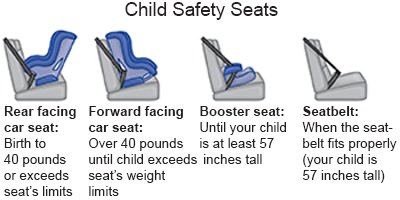
- Always put your child's car seat in the back seat. Never put your child's car seat in the front. This will help prevent him or her from being injured in an accident.
What can I do to keep my child safe in the sun and near water?
- Teach your child how to swim. Even if your child knows how to swim, do not let him or her play around water alone. An adult needs to be present and watching at all times. Make sure your child wears a safety vest when he or she is on a boat.
- Make sure your child puts sunscreen on before he or she goes outside to play or swim. Use sunscreen with a SPF 15 or higher. Use as directed. Apply sunscreen at least 15 minutes before your child goes outside. Reapply sunscreen every 2 hours.
What else can I do to keep my child safe?
- Encourage your child to use safety equipment. Encourage your child to wear a helmet when he or she rides a bicycle and protective gear when he or she plays sports. Protective gear includes a helmet, mouth guard, and pads that are appropriate for the sport.
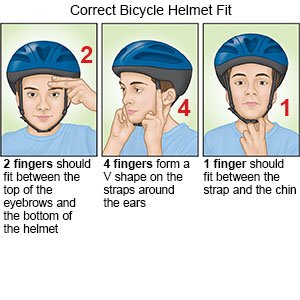
- Remind your child how to cross the street safely. Remind your child to stop at the curb, look left, then look right, and left again. Tell your child never to cross the street without an adult. Teach your child where the school bus will pick him or her up and drop him or her off. Always have adult supervision at your child's bus stop.
- Store and lock all guns and weapons. Make sure all guns are unloaded before you store them. Make sure your child cannot reach or find where weapons or bullets are kept. Never leave a loaded gun unattended.
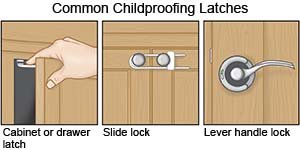
- Remind your child about emergency safety. Be sure your child knows what to do in case of a fire or other emergency. Teach your child how to call your local emergency number (911 in the US).

- Talk to your child about personal safety without making him or her anxious. Teach him or her that no one has the right to touch his or her private parts. Also explain that others should not ask your child to touch their private parts. Let your child know that he or she should tell you even if he or she is told not to.
What can I do to help my child get the right nutrition?
- Teach your child about a healthy meal plan by setting a good example. Buy healthy foods for your family. Eat healthy meals together as a family as often as possible. Talk with your child about why it is important to choose healthy foods.
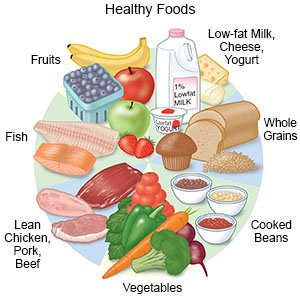
- Provide a variety of fruits and vegetables. Half of your child's plate should contain fruits and vegetables. He or she should eat about 5 servings of fruits and vegetables each day. Buy fresh, canned, or dried fruit instead of fruit juice as often as possible. Offer more dark green, red, and orange vegetables. Dark green vegetables include broccoli, spinach, romaine lettuce, and collard greens. Examples of orange and red vegetables are carrots, sweet potatoes, winter squash, and red peppers.
- Make sure your child has a healthy breakfast every day. Breakfast can help your child learn and focus better in school.
- Limit foods that contain sugar and are low in healthy nutrients. Limit candy, soda, fast food, and salty snacks. Do not give your child fruit drinks. Limit 100% juice to 4 to 6 ounces each day.
- Teach your child how to make healthy food choices. A healthy lunch may include a sandwich with lean meat, cheese, or peanut butter. It could also include a fruit, vegetable, and milk. Pack healthy foods if your child takes his or her own lunch to school. Pack baby carrots or pretzels instead of potato chips in your child's lunch box. You can also add fruit or low-fat yogurt instead of cookies. Keep his or her lunch cold with an ice pack so that it does not spoil.
- Make sure your child gets enough calcium. Calcium is needed to build strong bones and teeth. Children need about 2 to 3 servings of dairy each day to get enough calcium. Good sources of calcium are low-fat dairy foods (milk, cheese, and yogurt). A serving of dairy is 8 ounces of milk or yogurt, or 1½ ounces of cheese. Other foods that contain calcium include tofu, kale, spinach, broccoli, almonds, and calcium-fortified orange juice. Ask your child's healthcare provider for more information about the serving sizes of these foods.
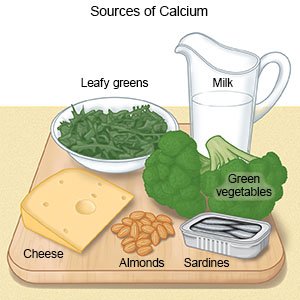
- Provide whole-grain foods. Half of the grains your child eats each day should be whole grains. Whole grains include brown rice, whole-wheat pasta, and whole-grain cereals and breads.
- Provide lean meats, poultry, fish, and other healthy protein foods. Other healthy protein foods include legumes (such as beans), soy foods (such as tofu), and peanut butter. Bake, broil, and grill meat instead of frying it to reduce the amount of fat.
- Use healthy fats to prepare your child's food. A healthy fat is unsaturated fat. It is found in foods such as soybean, canola, olive, and sunflower oils. It is also found in soft tub margarine that is made with liquid vegetable oil. Limit unhealthy fats such as saturated fat, trans fat, and cholesterol. These are found in shortening, butter, stick margarine, and animal fat.
- Let your child decide how much to eat. Give your child small portions. Let your child have another serving if he or she asks for one. Your child will be very hungry on some days and want to eat more. For example, your child may want to eat more on days when he or she is more active. Your child may also eat more if he or she is going through a growth spurt. There may be days when your child eats less than usual.
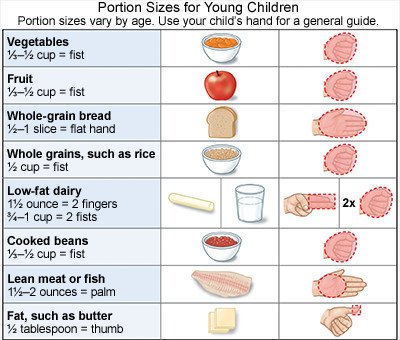
How can I help my child care for his or her teeth?
- Remind your child to brush his or her teeth 2 times each day. He or she also needs to floss 1 time each day. Mouth care prevents infection, plaque, bleeding gums, mouth sores, and cavities.
- Take your child to the dentist at least 2 times each year. A dentist can check for problems with his or her teeth or gums, and provide treatments to protect his or her teeth.
- Encourage your child to wear a mouth guard during sports. This will protect his or her teeth from injury. Make sure the mouth guard fits correctly. Ask your child's healthcare provider for more information on mouth guards.
What can I do to support my child?
- Encourage your child to get 1 hour of physical activity each day. Examples of physical activity include sports, running, walking, swimming, and riding bikes. The hour of physical activity does not need to be done all at once. It can be done in shorter blocks of time. Your child may become involved in a sport or other activity, such as music lessons. It is important not to schedule too many activities in a week. Make sure your child has time for homework, rest, and play.
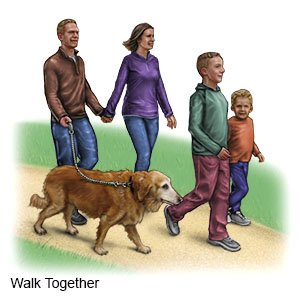
- Limit your child's screen time. Screen time is the amount of television, computer, smart phone, and video game time your child has each day. It is important to limit screen time. This helps your child get enough sleep, physical activity, and social interaction each day. Your child's pediatrician can help you create a screen time plan. The daily limit is usually 1 hour for children 2 to 5 years. The daily limit is usually 2 hours for children 6 years or older. You can also set limits on the kinds of devices your child can use, and where he or she can use them. Keep the plan where your child and anyone who takes care of him or her can see it. Create a plan for each child in your family. You can also go to https://www.healthychildren.org/English/media/Pages/default.aspx#planview for more help creating a plan.
- Help your child learn outside of the classroom. Take your child to places that will help him or her learn and discover. For example, a children's museum will allow him or her to touch and play with objects as he or she learns. Take your child to the library and let him or her pick out books. Make sure he or she returns the books.
- Encourage your child to talk about school every day. Talk to your child about the good and bad things that happened during the school day. Encourage him or her to tell you or a teacher if someone is being mean to him or her. Talk to your child about bullying. Make sure he or she knows it is not acceptable for him or her to be bullied, or to bully another child. Talk to your child's teacher about help or tutoring if your child is not doing well in school.
- Create a place for your child to do his or her homework. Your child should have a table or desk where he or she has everything he or she needs to do his or her homework. Do not let him or her watch TV or play computer games while he or she is doing his or her homework. Your child should only use a computer during homework time if he or she needs it for an assignment. Encourage your child to do his or her homework early instead of waiting until the last minute. Set rules for homework time, such as no TV or computer games until his or her homework is done. Praise your child for finishing homework. Let him or her know you are available if he or she needs help.
- Help your child feel confident and secure. Give your child hugs and encouragement. Do activities together. Praise your child when he or she does tasks and activities well. Do not hit, shake, or spank your child. Set boundaries and make sure he or she knows what the punishment will be if rules are broken. Teach your child about acceptable behaviors.
- Help your child learn responsibility. Give your child a chore to do regularly, such as taking out the trash. Expect your child to do the chore. You might want to offer an allowance or other reward for chores your child does regularly. Decide on a punishment for not doing the chore, such as no TV for a period of time. Be consistent with rewards and punishments. This will help your child learn that his or her actions will have good or bad results.
Which vaccines and screenings may my child get during this well child visit?
- Vaccines include influenza (flu) each year. Your child may also need Tdap (tetanus, diphtheria, and pertussis), HPV (human papillomavirus), meningococcal, MMR (measles, mumps, and rubella), or varicella (chickenpox) vaccines.

- Screenings may be used to check the lipid (cholesterol and fatty acids) levels in your child's blood. Screening for sexually transmitted infections (STIs) may also be needed. Anxiety screening may also be recommended. Your child's healthcare provider will tell you more about any screenings, follow-up tests, and treatments for your child, if needed.
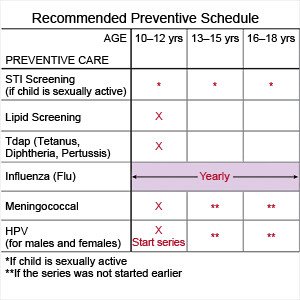
What do I need to know about my child's next well child visit?
Your child's healthcare provider will tell you when to bring him or her in again. The next well child visit is usually at 11 to 14 years. Tdap, HPV, meningococcal, MMR, or varicella vaccines may be given. This depends on the vaccines your child received during this well child visit. Your child may also need lipid or STI screenings if any was not done during this visit. Contact your child's healthcare provider if you have questions or concerns about your child's health or care before the next visit.
Care Agreement
You have the right to help plan your child's care. Learn about your child's health condition and how it may be treated. Discuss treatment options with your child's healthcare providers to decide what care you want for your child. The above information is an educational aid only. It is not intended as medical advice for individual conditions or treatments. Talk to your doctor, nurse or pharmacist before following any medical regimen to see if it is safe and effective for you.© Copyright Merative 2025 Information is for End User's use only and may not be sold, redistributed or otherwise used for commercial purposes.
Learn more about Well Child Visit at 9 to 10 Years
Care guides
Further information
Always consult your healthcare provider to ensure the information displayed on this page applies to your personal circumstances.
